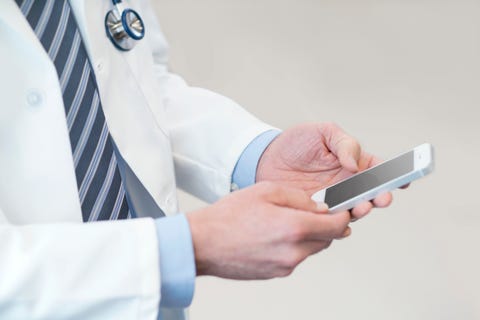
Any doctor will tell you that every guy needs a primary-care provider—a trusted physician who knows you, knows that your dad had a heart attack at age 40, helps you figure out how to tweak your life according to your health history…and heck, knows your name without looking at your chart first.
Except that for most of us, that’s not how it goes. First, the doctor never sees us, because the yearly visit has been called off. “There’s no reason for healthy men under 40, or anyone for that matter, to get annual checkups,” says Eric Topol, M.D., a professor of molecular medicine at Scripps Research in La Jolla, California, echoing the view of the Society of General Internal Medicine. Having an annual exam does not reduce your risk of death or serious disease, according to a review of 14 studies. When it comes to yearly checkups, “all the data shows the lack of value, and they should be strongly discouraged,” Dr. Topol says.
Second, we move around. “If you take a 21-year-old male in 2020 and ask, ‘Where are you going to get care today versus five, ten, or 20 years from now?’ he’s not going to know, because people change employers, health plans, and even doctors relatively frequently,” says Ateev Mehrotra, M.D., an associate professor of public health-care policy and medicine at Harvard Medical School. “So the question is: Is that relationship even possible?”
Add to that issues with cost and convenience and it’s no wonder nearly half of adults in the U. S. under age 30 don’t have a primary-care physician.
And—twist you didn’t see coming!—maybe that’s okay.
There are now many cheaper, more convenient ways to get medical help than waiting for a traditional doctor’s office to fit you in and potentially having to travel to get there. And if you’re basically healthy, you might do fine with these.
But with choice and convenience comes great responsibility. “Most millennials use urgent care, go online, talk to their friends, and think that’s health care,” says Allan H. Gorroll, M.D., a professor of medicine at Harvard Medical School. It’s not. A catch-as-catch-can health plan leads to a lot of issues not getting caught. With this approach, “some things may be overlooked or prescribed inappropriately,” he says.
So you’ve got to have a plan. Not all of these answers to medical-system frustration are equal. Some are welcome, some dodgy, some outright dangerous, and some ingenious.
Look, if you have a doctor you love, stick with them. And if you have a chronic illness like diabetes or high blood sugar that’s about to turn into diabetes, or if you’re at high risk for anything else (like heart disease), then yes, you’re going to need a main doctor.
But today, the old way is only one way to get what you need. If you’re going to bypass a PCP, then let us show you how to navigate what’s out there so that you find the best route to the best care.
Here’s the lowdown on which new ways to see the doctor spare you time, money, and scheduling hassles without endangering your health.
You get to talk to or videoconference with a real doctor without making an appointment or even leaving your living room/car/office/campsite. Some big insurance companies have partnered with big telehealth start-ups, including Teladoc, Doctor On Demand, and American Well, so these options may be part of your plan. In 2018, an estimated 7 million people visited a doc this way.
You can find and use a telehealth site or app yourself, but you’ll have to do some homework on your choices before dialing.
The pros: Speed. Ease. Since you’re calling or video chatting about a specific problem, such as a sore throat, you’ll likely be spared the “you need to lose weight” speech. And research has shown that people may be more honest in revealing symptoms or undesirable behaviors like alcohol consumption when disclosing to a computer.
The cons: Not all telehealth providers are equal—some have been scammy. So when choosing an app, look for one partnered with a known health-care entity, like Blue Cross Blue Shield or a hospital that you trust. Then see who the doctors are—some apps list providers’ names and contact information, so you can check them out online.
More than half of all millennials seek help from urgent care (like Concentra, CityMD, and MedExpress) or retail health clinics, found in drugstores, supermarkets, or “big box” stores. Retail clinics are typically manned by a nurse practitioner or physician’s assistant; they’re good at managing minor scrapes, colds, and fevers, and they can give you a flu shot. But they can’t X-ray you or stitch you up. Freestanding urgent-care centers are for pressing but non-life-threatening medical issues (so bypass them for an ER if you have chest pain) and are generally staffed by a licensed physician.
The pros: They’re cheaper and faster than the ER, they can usually send a report to you to keep on file (and to a doctor, if you have one), and they’re everywhere.
The cons: They may overprescribe meds. One recent study discovered that nearly half of people who dropped into urgent care with an ear infection, flu, allergies, asthma, bronchitis, or another viral upper-respiratory infection—none of which respond to antibiotics—got a prescription. Retail clinics had the best track record—antibiotics were inappropriately prescribed only 14 percent of the time there (and 17 percent of the time at a doctor’s office).
If you need a prescription for an issue like ED, genital herpes, performance anxiety, or hair loss, a few finger taps can get you one from a “digital health clinic” such as Hims.
The pros: No embarrassing in-person doctor visit needed. Fill out an online form—you’ll answer a lot of questions about your issue and your health history (you’ve got to be honest)—to determine if you’re eligible for the prescription you’re after. If a doc has questions or concerns, they may call you. Your medication arrives at your door a few days later.
Keep your look fresh and your sneakers performing their best with our official guide.
The cons: The idea of getting meds with little human contact ruffles the feathers of practically every careful human prescriber we know. But it might not be as sketchy as all that: Dr. Mehrotra sent college students undercover to test online prescription apps and sites. “My initial skepticism was tempered,” he says. That’s still not a ringing endorsement, by the way.
These fancy doctor’s offices/wellness centers are about as far as you can get from low-contact telehealth apps. Packages vary by company, but monthly fees can get you a round of initial diagnostics and a certain number of appointments with those physicians every year. The promise is that these docs have extra time to spend with you not only to solve your health problem but also to help determine lifestyle changes to keep it in check and prevent other issues. At a company called Forward, for instance, members receive genetic testing, body scans, and a personalized health plan. It considers itself a “supplement” to your insurance plan, not a substitute for it.
The pros: By virtue of the fact that they’re not bound to a 15-minute reimbursable visit, these doctors can take the time to understand patterns and concerns that aren’t just today’s problem. They also help with stress reduction and recommend healthy eating and exercise programs.
The cons: These physicians can feel like partners in your care, but they’re pricey. Forward runs about $149 a month, and Parsley Health costs about $150 to $250 a month, depending on how many visits a year you want. And the testing and blood work may not be included in the membership fees.
Different wearables can track your heart rate, heart rhythms, blood pressure, and sleep patterns. They also have a hint of Orwellian, Black Mirror creepiness, as some life-insurance companies have started using them to assess an individual’s activity level and grant discounts on premiums based on lifestyle. So make sure you’re aware of who’s watching your watch.
The pros: Your wearable may alert you to a heart problem (the Apple Watch Heart Rate app). And the Weill Cornell Alzheimer’s Prevention Clinic uses the Whoop’s sleep-activity data to track whether people experience a decrease in REM sleep, a potential risk factor for Alzheimer’s.
The cons: Wearables can be helpful for monitoring areas of concern, like not getting adequate sleep, but they can’t do a doctor’s work yet. Plus, watch-based EKGs may deliver endless data outputs that send guys in for hours of fruitless worry and testing.
By the start of 2019, more than 26 million Americans had spat into a tube and sent a DNA sample off to a lab to check genetic health risks and ancestry.
The pros: Knowing that your DNA indicates you’re at increased risk for certain diseases, including breast cancer (yes, even men can get it), age-related macular degeneration, and blood-clotting disorders, can help you step up efforts to prevent them.
The cons: It can be jarring to receive the news that you’re at risk for a disease via a report, and you need to work with a doctor to retest to see if the diagnosis is accurate—then find if what you’re doing to ward off a disease is adequate.

You can check out the latest casting calls and Entertainment News by clicking: Click Here
Click the logo below to go to the Home Page of the Website
Click the logo below to follow ETInside on Twitter
Click the logo below to follow ETInside on Facebook
Click the logo below to follow ETInside on Instagram
Click the logo below to follow ETInside on Pinterest
Click the logo below to follow ETInside on Medium
























